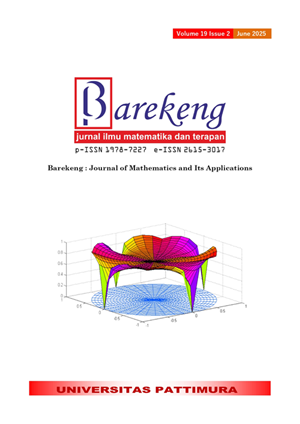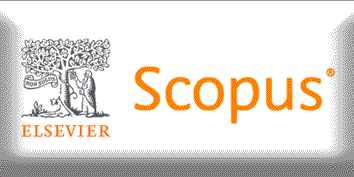ANALYZING THE LEVEL OF CREDIT FAILURE USING THE AUTOREGRESSIVE DISTRIBUTED LAG TO MAINTAIN STABILITY OF COMMERCIAL BANKS IN MALUKU PROVINCE
Abstract
Commercial banks are banks that carry out business activities conventionally and or based on sharia principles, which in their activities provide services in payment traffic. The health level of a commercial bank is the result of an assessment of the bank's condition based on risk and bank performance. Commercial Bank performance assessment can use the proxy of asset ownership, namely Return on Assets (ROA). While the risk assessment of commercial banks can use the credit risk proxy used is the Non-Performing Loan (NPL) ratio. The purpose of this study is to examine the Health Level of Commercial Banks in Maluku Province using ROA and NPL based on bank internal factors (bank specific) and macro and micro economic conditions in Maluku Province. The data used is quarterly time series data, namely in the first quarter of 2014 - first quarter of 2022. The method used is multivariate time series data analysis, namely the Autoregressive Distributed Lag (ARDL) model. The results obtained are the Health Level of Commercial Banks in Maluku Province in the first quarter of 2014 - first quarter of 2022 is classified as healthy and stable, even though the Maluku economy is experiencing the impact of the COVID-19 Pandemic. Internal (specific) bank factors are very dominant in influencing the performance and risk of Commercial Banks in Maluku Province compared to macro and micro economic factors. This means that the policies and performance of all parties related to Maluku's economic conditions need to be improved in maintaining the stability and soundness of commercial banks. In general, the performance of all parties in maintaining the health level of Commercial Banks in Maluku Province is very good, especially during the COVID-19 Pandemic.
Downloads
References
OJK, “BANK UMUM.” Accessed: Mar. 01, 2023. [Online]. Available: https://www.ojk.go.id/id/kanal/perbankan/pages/Bank-Umum.aspx
S. H. Boahene, J. Dasah, and S. K. Agyei, “CREDIT RISK AND PROFITABILITY OF SELECTED BANKS IN GHANA,” Research Journal of finance and accounting, vol. 3, no. 7, pp. 6–14, 2012.
G. Fainstein and I. Novikov, “THE COMPARATIVE ANALYSIS OF CREDIT RISK DETERMINANTS IN THE BANKING SECTOR OF THE BALTIC STATES,” Review of Economics & Finance, vol. 1, no. 3, pp. 20–45, 2011.
E. Nikolaidou and S. Vogiazas, “CREDIT RISK DETERMINANTS IN SUB-SAHARAN BANKING SYSTEMS: EVIDENCE FROM FIVE COUNTRIES AND LESSONS LEARNT FROM CENTRAL EAST AND SOUTH EAST EUROPEAN COUNTRIES,” Review of development finance, vol. 7, no. 1, pp. 52–63, 2017.
K. I. Nikolopoulos and A. I. Tsalas, “NON-PERFORMING LOANS: A REVIEW OF THE LITERATURE AND THE INTERNATIONAL EXPERIENCE,” NON-PERFORMING LOANS AND RESOLVING PRIVATE SECTOR INSOLVENCY: EXPERIENCES FROM THE EU PERIPHERY AND THE CASE OF GREECE, pp. 47–68, 2017.
R. De Haas64, B. Markovic65, and A. Plekhanov66, “REDUCING NON-PERFORMING LOANS IN EUROPE,” Non-Performing Loans, p. 107, 2017.
D. P. Louzis, A. T. Vouldis, and V. L. Metaxas, “MACROECONOMIC AND BANK-SPECIFIC DETERMINANTS OF NON-PERFORMING LOANS IN GREECE: A COMPARATIVE STUDY OF MORTGAGE, BUSINESS AND CONSUMER LOAN PORTFOLIOS,” J Bank Financ, vol. 36, no. 4, pp. 1012–1027, 2012.
R. Olivares-Caminal and A. Miglionico, “NON-PERFORMING LOANS: CHALLENGES AND OPTIONS FOR BANKS AND CORPORATIONS,” NON-PERFORMING LOANS AND RESOLVING PRIVATE SECTOR INSOLVENCY: EXPERIENCES FROM THE EU PERIPHERY AND THE CASE OF GREECE, pp. 17–45, 2017.
A. Boudriga, N. Boulila Taktak, and S. Jellouli, “BANKING SUPERVISION AND NONPERFORMING LOANS: A CROSS‐COUNTRY ANALYSIS,” Journal of financial economic policy, vol. 1, no. 4, pp. 286–318, 2009.
J. P. S. Sheefeni, “THE IMPACT OF MACROECONOMIC DETERMINANTS ON NON-PERFORMING LOANS IN NAMIBIA,” International Review of Research in Emerging Markets and the Global Economy (IRREM), vol. 1, no. 4, pp. 612–632, 2015.
M. A. Rahman, M. Asaduzzaman, and M. S. Hossin, “IMPACT OF FINANCIAL RATIOS ON NON-PERFORMING LOANS OF PUBLICLY TRADED COMMERCIAL BANKS IN BANGLADESH,” International Journal of Financial Research, vol. 8, no. 1, pp. 181–188, 2017.
D. Hillier, S. Ross, R. Westerfield, J. Jaffe, and B. Jordan, CORPORATE FINANCE, 4e. McGraw Hill, 2019.
Bank Indonesia, “LAPORAN PEREKONOMIAN PROVINSI MALUKU NOVEMBER 2021,” Nov. 2021.
V. A. H. Barata and T. Faturohman, “EMPIRICAL ANALYSIS OF THE EFFECTS OF MICROECONOMICS AND MACROECONOMICS FACTORS ON BANK-RISK TAKING BEHAVIOUR BEFORE AND AFTER,” The Finance-Innovation Nexus: Implications for Socio-Economic Development, p. 177, 2024.
M. H. Pesaran and Y. Shin, AN AUTOREGRESSIVE DISTRIBUTED LAG MODELLING APPROACH TO COINTEGRATION ANALYSIS, vol. 9514. Department of Applied Economics, University of Cambridge Cambridge, UK, 1995.
M. H. Pesaran, Y. Shin, and R. J. Smith, “BOUNDS TESTING APPROACHES TO THE ANALYSIS OF LEVEL RELATIONSHIPS,” Journal of applied econometrics, vol. 16, no. 3, pp. 289–326, 2001.
Bank Indonesia, PERATURAN BANK INDONESIA NOMOR: 12/1/PBI/20211 TENTANG PENILAIAN TINGKAT KESEHATAN BANK UMUM. Indonesia, 2011.
N. Shrestha, “DETECTING MULTICOLLINEARITY IN REGRESSION ANALYSIS,” Am J Appl Math Stat, vol. 8, no. 2, pp. 39–42, 2020.
D. A. Belsley, “CONDITIONING DIAGNOSTICS: COLLINEARITY AND WEAK DATA IN REGRESSION,” (No Title), 1991.
M. Wooldridge Jeffrey, “INTRODUCTORY ECONOMETRICS: A MODERN APPROACH,” South-Western Cengage Learning. Michigan State University, 2006.
Copyright (c) 2025 Norisca Lewaherilla, Lexy Janzen Sinay, Ferina Lestari Damamain, Marsa Sopaheluwakan

This work is licensed under a Creative Commons Attribution-ShareAlike 4.0 International License.
Authors who publish with this Journal agree to the following terms:
- Author retain copyright and grant the journal right of first publication with the work simultaneously licensed under a creative commons attribution license that allow others to share the work within an acknowledgement of the work’s authorship and initial publication of this journal.
- Authors are able to enter into separate, additional contractual arrangement for the non-exclusive distribution of the journal’s published version of the work (e.g. acknowledgement of its initial publication in this journal).
- Authors are permitted and encouraged to post their work online (e.g. in institutional repositories or on their websites) prior to and during the submission process, as it can lead to productive exchanges, as well as earlier and greater citation of published works.






1.gif)



